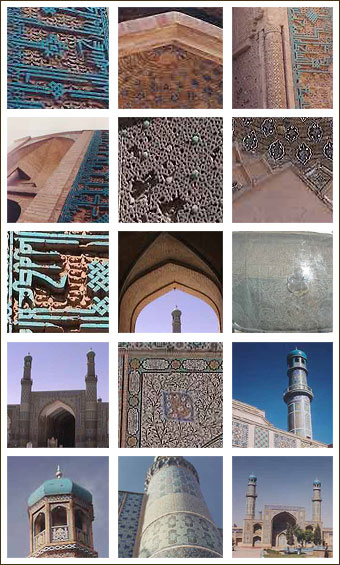 |
MASJID-E JAMI,
The great mosque of Herat is one of Afghanistan’s
more attractive sights. The form in which it stands today
was originally laid out on the site of an earlier 10th century
mosque in the year 1200 by the Ghrid Sultan Ghiyasuddin. Only
tantalizing fragments of Ghorid decoration remain except for
a splendid portal situated to the south of the main entrance.
(enter from front situated to the south of the main entrance.
(Enter from front garden through small door in mosque wall.)
A bold Kufic inscription, including the name of the monarch,
stands in high Persian-blue relief above a soft buff background
intricately designed with floral motifs in cut brick. The
combination of the bright, bold straight-lined script contrasts
dramatically with the graceful delicacy of the background.
It is an exciting example of the artistic sophistication of
the ghorids. This stunning decoration was hidden under Timurid
decorative tile until the winter of 1964 when experts working
with the Kabul Museum removed the later Timurid decoration
dating from the 15th century. The upper section of the Timurid
arch, lower that the ghorid arch, has been left for interesting
comparisons. Ghorid geometric patterns give way to increasingly
exuberant floral patterns in the timurid decoration; coloured
tile used sparingly only as an accent by the Ghorid is used
to cover every inch of the architectural facade by their successors.
The lavish Timurid decorative restoration covered the entire
surface of the mosque but it disappeared as the unstable political
climate enveloped Herat during the 400 years following Timurid
rule. Photographs taken in the courtyard in the early tears
of the 20th century show only piles of rubble against bleak,
white-washed walls. In 1943 an ambitious restoration program
began and continues to today. It is the creation of three
noted Herati artists, Fikhri Seljuki Herawi, Mohammad Sa’id
Mashal-i Ghori, and the accomplished calligrapher, Mohammad
Ali Herawi. A visit to the mosque workshop (to left of corridor
leading from the front garden into the courtyard) is highly
recommended.
The huge bronze cauldron in the courtyard dates from the reign
of the Kart kings of Herat (1332-1381). It was originally
used as a receptacle fro sherbet (a sweet drink) which was
served to workshipers on feast days. It is now used for donations
for the upkeep of the mosque."
..." Better preserved fragments of Ghorid decoration
may be seen on the arches of the short corridors on either
side of the main iwan where the mehrab (prayer niche) is let
into the west wall. Here the work was executed in cut brick
and molded terracotta. In the south corridor, there is a Kufic
inscription with a floral background done in a distinctive
angular “brambly” style little seen elsewhere.
Above this band there are two large panels of brickwork interspersed
with x-form plugs and bordered with an undulating chain of
molded terracotta arabesques. Simple in concept, the use of
plain unadorned brick for design and texture produces a thoroughly
handsome effect which is both aesthetically pleasing and strong.
Between these brick panels there is a narrower panel filled
with a complicated geometric design formed by a series of
buds and interconnecting tendrils.
All that is left of the splendid Timurid restoration undertaken
by Sultan Husain Baiqara’s prime minister Mir Ali Sher
Nawai in 1498 may be found on the inside of the arcade in
the southwest corner of the courtyard. The interiors fo these
five arches are decorated with narrow strips of blue tile
hexagons and octagons sprinkled with tiny golden flowers.
Plain pink-beige tile plaques slightly in relief fill the
spaces between. The relief and the tiny flowers produce an
illusion of depth and mobility which is extremely effective.”
From Dupree, N. H. An historical guide to Afghanistan. Kabul.
1977. p.250
CONDITION:
Well preserved by the community
|
|
MASJID-E
JAMI
|
|


